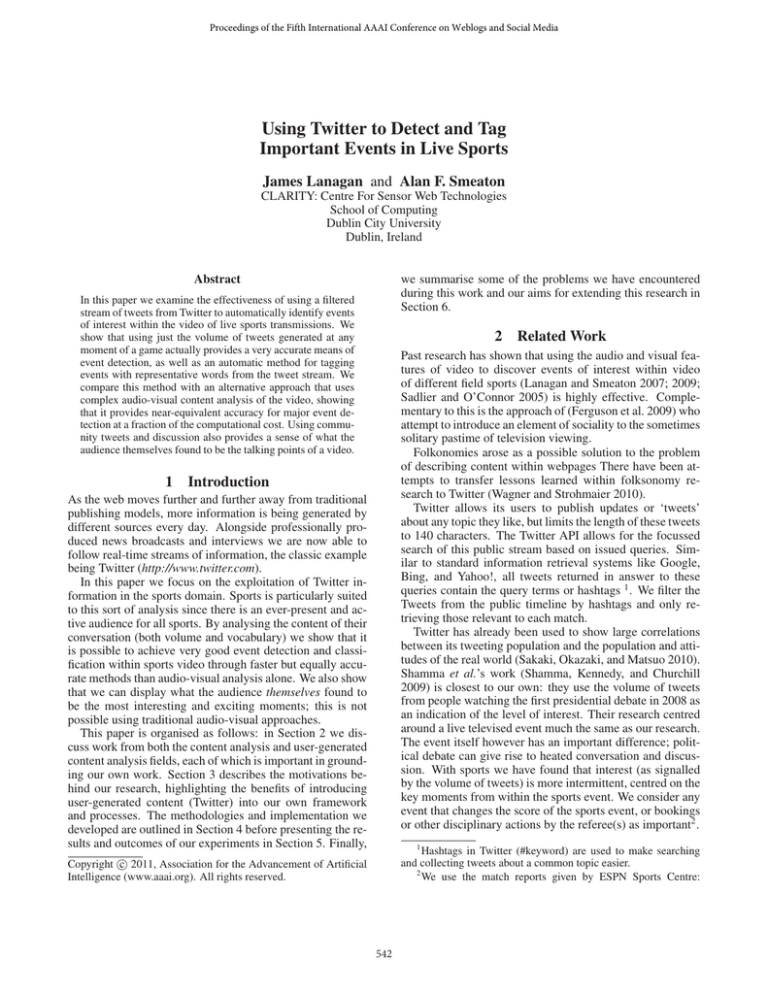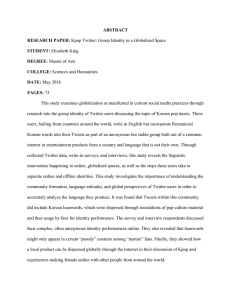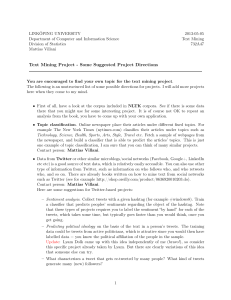
Proceedings of the Fifth International AAAI Conference on Weblogs and Social Media
Using Twitter to Detect and Tag
Important Events in Live Sports
James Lanagan and Alan F. Smeaton
CLARITY: Centre For Sensor Web Technologies
School of Computing
Dublin City University
Dublin, Ireland
we summarise some of the problems we have encountered
during this work and our aims for extending this research in
Section 6.
Abstract
In this paper we examine the effectiveness of using a filtered
stream of tweets from Twitter to automatically identify events
of interest within the video of live sports transmissions. We
show that using just the volume of tweets generated at any
moment of a game actually provides a very accurate means of
event detection, as well as an automatic method for tagging
events with representative words from the tweet stream. We
compare this method with an alternative approach that uses
complex audio-visual content analysis of the video, showing
that it provides near-equivalent accuracy for major event detection at a fraction of the computational cost. Using community tweets and discussion also provides a sense of what the
audience themselves found to be the talking points of a video.
1
2
Related Work
Past research has shown that using the audio and visual features of video to discover events of interest within video
of different field sports (Lanagan and Smeaton 2007; 2009;
Sadlier and O’Connor 2005) is highly effective. Complementary to this is the approach of (Ferguson et al. 2009) who
attempt to introduce an element of sociality to the sometimes
solitary pastime of television viewing.
Folkonomies arose as a possible solution to the problem
of describing content within webpages There have been attempts to transfer lessons learned within folksonomy research to Twitter (Wagner and Strohmaier 2010).
Twitter allows its users to publish updates or ‘tweets’
about any topic they like, but limits the length of these tweets
to 140 characters. The Twitter API allows for the focussed
search of this public stream based on issued queries. Similar to standard information retrieval systems like Google,
Bing, and Yahoo!, all tweets returned in answer to these
queries contain the query terms or hashtags 1 . We filter the
Tweets from the public timeline by hashtags and only retrieving those relevant to each match.
Twitter has already been used to show large correlations
between its tweeting population and the population and attitudes of the real world (Sakaki, Okazaki, and Matsuo 2010).
Shamma et al.’s work (Shamma, Kennedy, and Churchill
2009) is closest to our own: they use the volume of tweets
from people watching the first presidential debate in 2008 as
an indication of the level of interest. Their research centred
around a live televised event much the same as our research.
The event itself however has an important difference; political debate can give rise to heated conversation and discussion. With sports we have found that interest (as signalled
by the volume of tweets) is more intermittent, centred on the
key moments from within the sports event. We consider any
event that changes the score of the sports event, or bookings
or other disciplinary actions by the referee(s) as important2 .
Introduction
As the web moves further and further away from traditional
publishing models, more information is being generated by
different sources every day. Alongside professionally produced news broadcasts and interviews we are now able to
follow real-time streams of information, the classic example
being Twitter (http://www.twitter.com).
In this paper we focus on the exploitation of Twitter information in the sports domain. Sports is particularly suited
to this sort of analysis since there is an ever-present and active audience for all sports. By analysing the content of their
conversation (both volume and vocabulary) we show that it
is possible to achieve very good event detection and classification within sports video through faster but equally accurate methods than audio-visual analysis alone. We also show
that we can display what the audience themselves found to
be the most interesting and exciting moments; this is not
possible using traditional audio-visual approaches.
This paper is organised as follows: in Section 2 we discuss work from both the content analysis and user-generated
content analysis fields, each of which is important in grounding our own work. Section 3 describes the motivations behind our research, highlighting the benefits of introducing
user-generated content (Twitter) into our own framework
and processes. The methodologies and implementation we
developed are outlined in Section 4 before presenting the results and outcomes of our experiments in Section 5. Finally,
1
Hashtags in Twitter (#keyword) are used to make searching
and collecting tweets about a common topic easier.
2
We use the match reports given by ESPN Sports Centre:
c 2011, Association for the Advancement of Artificial
Copyright Intelligence (www.aaai.org). All rights reserved.
542
3
Motivation
matches. The durations shown are the maximum event spans
using the least/greatest values for start/end second. We feel
it is better to show too much of the original video during a
highlight than lose some of the highlight content itself.
We use the method of hashtag filtering – as explained in
Section 3 – to construct and retrieve filtered tweets about the
football matches we recorded, 4x soccer and 4x international
rugby. The numbers and frequency of tweets per game vary
greatly as shown in Table 2, with one of the soccer games
having far less than any other game. This was a far lower
profile game than all the others, yielding some interesting
results and problems in terms of event detection.
The detection and easy navigation of highlights within sports
media is something that is both appreciated and desired by
viewers (Lanagan and Smeaton 2007). The combination of
both audio and visual video content features has been able
to successfully detect many of the most important events
within a match (Sadlier and O’Connor 2005)3 .
Our main motivations for using Twitter as a source of
information are speed and enrichment. By looking at the
words that people are using within their tweets, we are able
to create tags that best describe and classify the highlights
to which they are temporally aligned. Performing audiovisual analysis is time-consuming; Twitter provides a realworld approximation of the interest, allowing for the realtime segmentation and display of highlights.Using the Twitter stream alone however ignores any of the content features
themselves, leading to disorientating initial frames that appear to jump into the middle of the action. To counteract
this, we combine the tweet information with a video shotboundary detection algorithm (SBD) so as to provide more
intelligently bounded highlight videos.
4
Table 2: Tweet statistics per game for the 4 soccer, and 4
rugby matches.
Tweets
Game
Avg/Min. Total
ACM-ManU
19.76 1877
Cov-Por
1.03
101
Liv-Rea
32.3 4073
ManU-ManC
12.95 1256
Eng-Ire
33.42 3108
Eng-Wal
35.30 3142
Fra-Ire
27.53 2615
Wal-Sco
23.86 2291
Experiments
We asked 6 annotators to each mark up the events of interest
within 3 of the videos we recorded (all of these videos are of
soccer matches, though we speculate event descriptions for
rugby, American football, or other field sports may prove
slightly easier due to the stop-start nature of those sports).
While there is no set convention for designating hashtags
to tweets within Twitter in general, one has started to grow
around sports-related tweets. This was highlighted during
the World Cup 2010 when Twitter had their own hashtagfiltered pages for each team, game, and overall competition.
We have constructed complex queries using this same
convention (e.g. #ire #eng #6nations for the 6 nations Ireland vs. England rugby football match) so as to retrieve the
maximum number of relevant tweets for each sports video.
In the later experiments to find suitable tags, non-English
tweets are ignored. In this research we are not interested
in any tweets that occur outside the bounds of actual live
gameplay including tweets during half-time or extra-time intervals.
The aim of the process here is to be able to provide an
end-user with full highlights of a match through their mobile
device, or as part of a larger system (Lanagan and Smeaton
2009). As with previous systems, we look to combine simple content analysis with more complex information. In the
past this was complex audio-visual information (Sadlier and
O’Connor 2005), providing per-second confidence values
for event occurrence within the video. In our approach, we
substitute this information with per-second tweet counts allowing us to use the same overall technique, dramatically
reducing computational complexity.
Sports video contains many hard cuts leading to shots that
vary greatly in duration. These shots alone would not provide a good basis for highlight retrieval and browsing, and
so we combine the initial shot boundary detection (SBD)
results with some heuristic measures. As we have seen, significant events are in the region of 60 seconds in duration.
We amalgamate the shots into segments using the following
Table 1: Significant event boundaries and durations in seconds as marked up by our annotators.
1
2
3
4
5
6
7
8
Boundary
start
end
start
end
start
end
start
end
start
end
start
end
start
end
start
end
Std. Dev
3.93
0.84
4.02
8.99
3.27
8.77
3.78
1.60
2.48
7.71
3.78
3.39
4.36
6.50
48.6
30.2
Min/Max
1288
1350
5584
5688
3995
4080
2730
2780
5617
5730
6347
6414
945
1028
2390
2550
Duration (Secs)
62
104
85
50
113
67
83
160
Table 1 shows the event boundary decisions in seconds
made by our annotators for the 8 goals scored during the 3
http://soccernet.espn.go.com/
3
The detection approach used is multi-modal and relies on both
audio and visual information streams to determine confidence levels. Six Support Vector Machine (SVM) classifiers are used that
detect the presence of player close-ups, crowd shots, scoreboard
changes, increased audio activity, playing field boundaries and increased visual activity. A more detailed description of training and
testing maybe be found in the original paper.
543
False
Foul
Goal
Goal + Y/Cs
Miss
False
False
Figure 1: Normalised per-segment event confidences for
each of the matches (Twitter graph shown with shading.).
Injury
Goal
Shot
Miss
Sub
Shot
Figure 2: Comparison of events captured by each combination. Yellow events found by both algorithms, red and blue
found by their respective algorithms.
procedure:
(i) Find the top 10 per-second event confidence maxima as given
by either Twitter or audio-visual features.
in the Twitter data until after the event is finished – in this
sense Twitter is truly reactionary.
(ii) Create 60 second windows around these local maxima.
(iii) Combine shots together until a segment is formed that is of at
least 60 seconds in duration.
Table 3: Top terms occurring for given events within different games. Occurrences are in brackets
(iv) If an event is present, continue the segment until the event has
completed.
FRA-IRE:Penalty
#6nations (44)
flannery (19)
#rugby (17)
lucky (8)
ireland (6)
s (6)
penalty (5)
(v) If two events are within 30 seconds of each other, combine the
events and do not end the segment until both events are contained.
(vi) Find the event confidence for the segment by calculating the
mean event confidence of every second contained within the segment.
(vii) If the video is not complete, return to Step (iii).
We choose to return only the 10 most significant events
within a video, or as many events that are found with higher
confidence values than a given threshold.
The dynamic threshold is now chosen in a second pass.
We average across entire segments rather than across minutes etc., since minutes are no longer the measure of interest.
Figure 1 shows the normalised per-segment event confidences for a recorded matches matches were recorded between late January and early March 2010, and show a wide
range of sporting competitions.
4.1
Sub
Foul
ManU-ManC:Goal
#manutd (50)
penalty (46)
1 (44)
#mufc (42)
#mancity (34)
tevez (30)
#mcfc (29)
WAL-SCO:Try
#6nations (299)
wales (90)
scotland (62)
#rugby (56)
#wales (44)
24 (44)
game (38)
When determining tags for the events we remove all
non-English tweets as these are considered noise for taggeneration purposes. We then group all tweets that occur
within the event boundaries, and generate a ‘bag-of-words’
from these tweets. We ignore any term that occurs less than
3 times in an events bag-of-words. Highly-frequent terms
are removed using the WordNet stoplist4 . We can see from
Table 3 that there are still many words left within the corpus
that are in no way discriminatory (i.e. is, was, and single letters). Removal of all words that are not of some minimum
length, and Hashtags should perhaps have been performed
as they have no discriminative value.
Twitter as Reaction
It is important to consider the difference between audiovisual and Twitter information as interpretations of event
occurrences. The 6 SVMs used to provide event confidence
values do so by looking for increases in audio and visual
excitement. While this excitement is a result of crowd and
editors’ reactions to events within the game, the reaction is
almost instantaneous; this is not true of Twitter. We can
not look to the segments with the highest confidence values in the Twitter combination for the presence of an event,
but instead for the near-immediate reaction to an event. We
therefore consider events to begin at the start of the segment
preceding a local maximum, and end when that local maximum’s segment ends. While audio-visual features such as
field end-lines and increased crowd noise may be used as indicators of an event about to happen, there are no indicators
5
Results
The combination of Twitter filtered search result with SBD
content analysis appears to be very effective in detecting significant events. Not only this but it also provides more accurate measures of the actual significance of the events. Table 4 shows the comparison of the two techniques’ abilities
to find all ground-truthed events within our three annotated
soccer matches.
We can see that the events missed by the Twitter algorithm are bookings, but all goals are found. The segmentation technique also succeeds in finding all of an event (length
4
http://www.d.umn.edu/t̃pederse/Group01/WordNet/wordnetstoplist.html
544
but the added computational complexity of the audio-visual
approach was specifically what we are attempting to avoid.
Table 4: Ground truth events found consisting of goals(G)
and yellow cards(Y/c). Events missed are in brackets.
Game
Twitter
A/V Features
Cov-Por
2 G (2 Y/c) All (Many False Pos.)
Liv-Rea
3 G, 1 Y/c (3 Y/c) All (Many False Pos.)
ManU-ManC 3 G, 2 Y/c (1 Y/c)
2 G, 3 Y/c (1 G)
7
Conclusions
In this paper we have shown that it is possible to use the publicly available tweets about a sports event to aid in event detection and summary generation for associated media. Using
a filtered stream of tweets we can identify and tag the most
significant events within 2 different field sports with a high
degree of accuracy and success. We believe that the power
of our approach lies within its seeming simplicity, allowing
for equivalent results to far more computationally complex,
and time consuming approaches.
Acknowledgments
This work is supported by Science Foundation Ireland under
grant number 07/CE/I1147.
T
A/V
T
A/V
T
A/V
T
A/V
T
A/V
T
A/V
T
A/V
T
A/V
References
Ferguson, P.; Gurrin, C.; Lee, H.; Sav, S.; Smeaton, A. F.;
O’Connor, N. E.; Choi, Y.-H.; and Park, H. 2009. Enhancing
the functionality of interactive tv with content-based multimedia analysis. In CBTV 2009: Workshop on Content-Based
Audio/Video Analysis for Novel TV Services, 495–500. San
Diego, California, USA.: IEEE Computer Society.
Lanagan, J., and Smeaton, A. 2007. SportsAnno: What Do
You Think? In RIAO’2007: Proceedings of the 8th Conference on Information Retrieval and its Applications.
Lanagan, J., and Smeaton, A. F. 2009. Query Independent
Measures of Annotation and Annotator Impact. In ESAIR
’09: Proceedings of the WSDM ’09 Workshop on Exploiting Semantic Annotations in Information Retrieval, 35–38.
Barcelona, Spain: ACM.
Sadlier, D., and O’Connor, N. 2005. Event Detection in
Field Sports Video Using Audio-Visual Features and a Support Vector Machine. IEEE Transaction on Circuits and Systems for Video Technology 15(10):1225.
Sakaki, T.; Okazaki, M.; and Matsuo, Y. 2010. Earthquake
Shakes Twitter Users: Real-time Event Detection by Social
Sensors. In WWW ’10: Proceeding of the 19th International
Conference on World Wide Web.
Shamma, D. A.; Kennedy, L.; and Churchill, E. F. 2009.
Tweet the Debates: Understanding Community Annotation
of Uncollected Sources. In WSM ’09: Proceedings of the
first SIGMM workshop on Social media, 3–10. Beijing,
China: ACM.
Wagner, C., and Strohmaier, M. 2010. The Wisdom
in Tweetonomies: Acquiring Latent Conceptual Structures
from Social Awareness Streams. In Proc. of the Semantic
Search 2010 Workshop (SemSearch2010).
Figure 3: A comparison of event detection accuracy across
the 8 games, and 2 techniques.
in seconds) as annotated by our annotators, and not truncating it due to simple tweet volume. The audio-visual feature combination is slightly more effective in finding events
within the video, but this effectiveness is tempered by the
large number of false positives found. It should be noted
that because of the false positives that are found, not all of
the significant events will be in the top 10 event listing.
Looking at the effectiveness of the Twitter-SBD combination to detect events across the remaining matches, we
find that it has a 100% accuracy rate in finding goals in soccer matches overall, finding all 5 goals in the ACM-ManU
match. For rugby it only misses 2 of the 18 tries in the 4
rugby matches, both of which occur in quick succession to
another significant event. The detection rate for penalties
within the rugby matches is slightly lower at ∼80%, these
occurring more frequently. With regards false positives, the
audio-visual algorithm finds far more in the rugby matches
than in the soccer matches.
6
Future Work
One of the major issues we encountered was a reliance upon
conversation and tweet volume as a principle input; without tweets the analysis is not possible. it is also true that the
number of tweets over the course of a game can significantly
affect the performance of our algorithm. Another problem is
highlighted in Figure 1. The level of excitement and conversation in general rose after a late goal, introducing an ‘event
shadow’ as can be seen in the last quarter of the game, and
inflating the overall average throughout the game.
To ameliorate both of these issues we could introduce
some form of smoothing or windowing. A second approach
is to combine the outputs of both of our approaches to give a
combined confidence value for each event. This would have
the advantage of being less reliant on the number of tweets,
545









